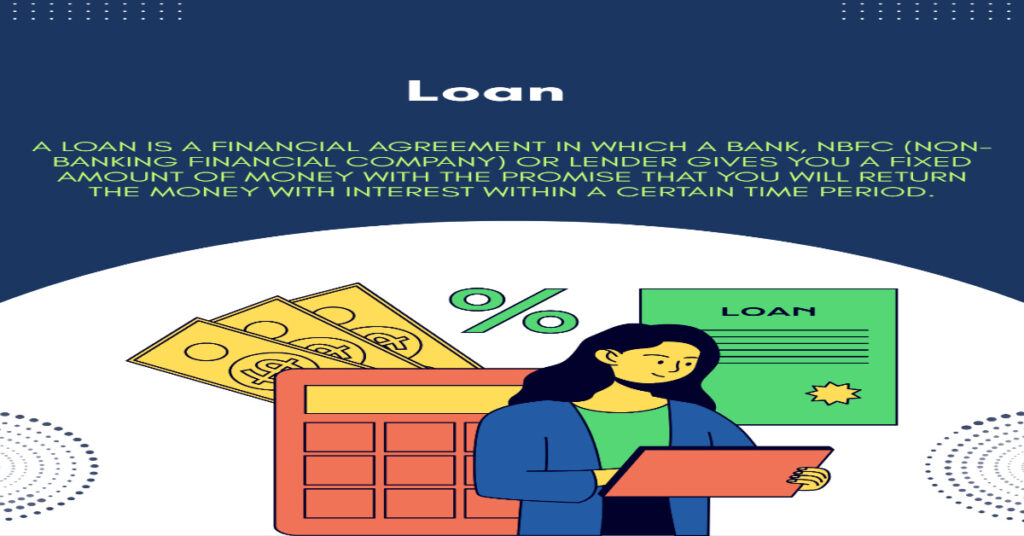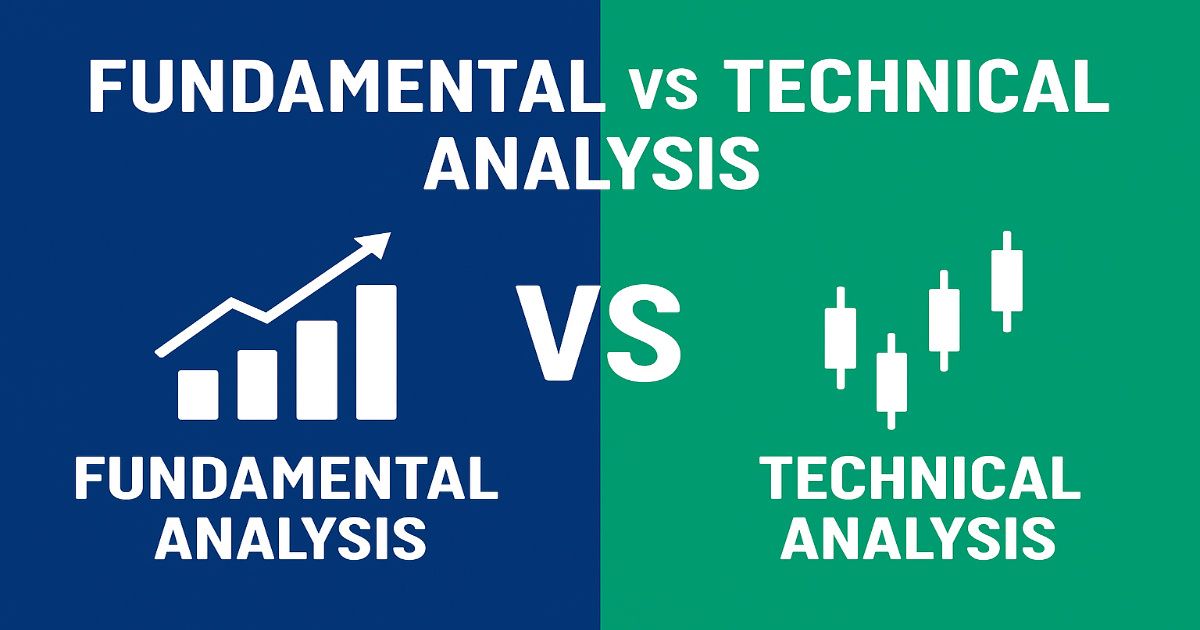Introduction:
In today’s time, financial need can arise at any time – be it an emergency, education, or buying a house. When we do not have as much money as is required, then we choose the option of a loan.
So let us understand what a loan is, how it works, and what are the basic terms related to it.

What Is a Loan?
A loan is a financial agreement in which a bank, NBFC (Non-Banking Financial Company) or lender gives you a fixed amount of money with the promise that you will return the money with interest within a certain time period.
This repayment is usually done through EMI (Equated Monthly Installment).
Main Components of a Loan
Principal Amount
The amount you borrow (say ₹1,00,000) – is called the principal.
Interest Rate
The money that the bank or lender charges you extra – is called the interest rate. It can be fixed or floating.
Tenure
For how long you have to repay the loan – is called the tenure or repayment period.
EMI
The monthly installment that you repay – it includes both principal + interest.
Basic For Loan Eligibility
- Minimum age: 21 years
- Regular income (job ya business)
- score (CIBIL 700+ recommended)
- Valid ID, address proof, income proof
Types of Loan
- Personal Loan – for any personal need
- Home Loan – for buying a house
- Car Loan – vehicle finance
- Education Loan – for studies
- Business Loan – to start or grow a business
- Gold Loan – against gold
- Loan Against Property – taking loan by mortgaging property
Loan Process Step-by-Step
- Understand the requirement
- Choose the right type of loan
- Check eligibility
- Prepare documents
- Apply (online or branch visit)
- The loan is approved after verification
- Disbursement is made to your account
Pros and Cons of Loan
Pros:
- Get big funds without any delay
- Flexible repayment options
- Helpful in emergencies
Cons
- There is interest burden
- Credit score goes down in case of default
- Penalty is charged in case of missed payment
Loan is a useful tool for financial planning, the only condition is that you repay wisely. Whenever you have to take a loan, evaluate the interest rate, tenure, and repayment capacity carefully. Responsible borrowing is smart borrowing.
How Does a Loan Work?
The process of taking a loan follows a structured system in which there is a legal agreement between the borrower (who is taking the loan) and the lender (bank or NBFC). This process includes borrowing money, repaying it, and paying interest.
✅ Loan kaam kaise karta hai?
- Loan Application: The borrower files the application with his required amount, tenure, and income details.
- Eligibility Check: Lender borrower ki credit score, income proof, aur financial background check karta hai.
- Loan Approval: Agar borrower eligible hota hai to lender loan ko approve kar deta hai.
- Loan Disbursement: Approved loan amount borrower ke bank account me transfer kar diya jata hai.
- Repayment Period: The borrower repays the loan in the form of a fixed monthly amount (EMI), which includes the principal and interest.
- Loan Closure: On completion of the loan tenure, if all the payments are made, the loan is officially closed.
🔁 What is interest and EMI?
- Interest: The lender’s charge (profit) on the loan amount, expressed as an annual percentage (e.g., 10% per annum).
- EMI (Equated Monthly Installment): This is the amount you pay every month. It is principal + interest.
Example: If you take a loan of ₹1,00,000 at 12% interest for 1 year, then you will have to pay EMI of approximately ₹8,885 every month.
Important Loan Terms to Know
Whenever you plan to take a loan, you should be clear about the meaning of some important financial terms. These terms are very useful at the time of loan agreement, EMI calculation, and repayment.
Principal Amount
This is the amount you borrow from the lender.
Example: If you take a loan of ₹2,00,000, then this principal is ₹2,00,000 only.
Interest Rate
This is the lender’s profit percentage that you have to pay on the loan.
The interest can be fixed or floating.
Example: 10% annual interest rate means ₹10,000 per ₹1,00,000 every year.
Tenure (Loan Duration)
This is the time period in which you have to repay the entire loan amount.
Example: Personal loan tenure is usually 1 to 5 years, while home loan tenure can be up to 20–30 years.
EMI (Equated Monthly Installment)
This is the monthly payment that you have to make to repay the loan. EMI includes both principal + interest.
EMI = Principal + Interest divided over loan tenure.
Processing Fee
Banks or MFCs charge a processing charge after approving the loan, which can range from 0.5% – 3%.
fee non-refundable
Credit Score (CIBIL Score)
This is a 3-digit score (range 300–900) that indicates your loan repayment history.
If the score is 750+ then the chances of loan approval are higher.
Tip: Understanding every loan term thoroughly makes you a smart borrower. Taking a loan without understanding it can create problems in the future.Loan calculate
Tips to Get a Loan Fast
In today’s fast-paced world, there is sometimes an urgent need for financial help – be it a medical emergency, business requirement or personal expense. In such a situation, getting a loan quickly reduces stress.
You can speed up the loan approval process by following the tips given below:
1.Improve your credit score (be it 750+)
The first factor for loan approval is your credit score.
If your score is 750+ then the bank or NBFC approves the loan immediately.
Tip: Pay credit card bills on time and avoid multiple loans.
2.Documents Ready
Keep these basic documents ready before applying for a loan:
- Aadhaar card
- PAN card
- Income proof (salary slips ya ITR)
- Bank statement (last 6 months)
- Address proof
Documents delay and your loan delay.
3.Online Loan Apply
Nowadays there are many instant loan apps and digital banks which disburse loans within 10–15 minutes.
Example: KreditBee, Hero Instant Loan, IDFC first Bank, etc. (Choose NBFC Registered Company)
4.Pre-Approved Offers Check
If you have an account in any bank, they give you pre-approved loan offers. These offers require minimal documents and get instant approval.
You can check by logging into bank app or net banking.
5.Please Consider NBFC
NBFCs (Non-Banking Financial Companies) are a little more flexible than banks.
They can give you a loan even if your credit score is average.
NBFC such as Tata Capital, Fullerton, Indiabulls, etc. are known for fast approvals.
📝 Conclusion
In today’s financial world, loan is a powerful tool that helps you meet your personal or professional needs. Whether you want to buy a house, expand your business or need emergency funds – a loan taken in the right way can make your life easier.
In this blog, we covered:
- What is a loan and how does it work
- Major loan types available in India
- Key terms of loan process (like EMI, interest rate, credit score)
- Practical tips to take a loan quickly and easily
If you are planning to take a loan in 2025, keep your credit score strong, keep the required documents ready and choose the right lender. Smart decisions can give you a stress-free borrowing experience.






